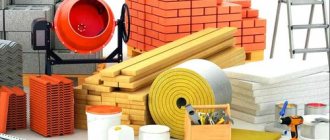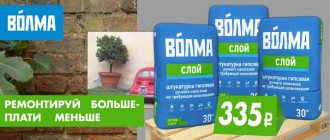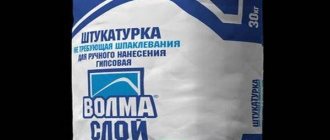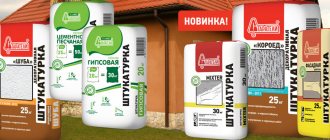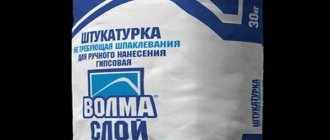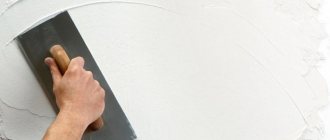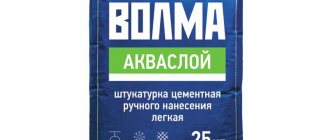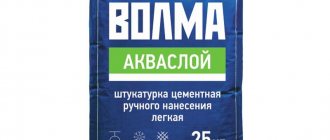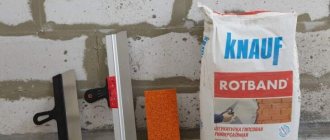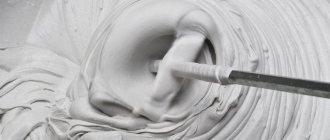We all want to have cottages that have smooth and neat surfaces. Plaster is a mass of thick mortar, which is intended for plastering (leveling) surfaces. This mass also protects the façade from adverse environmental influences.
Volma is a well-known Russian company, founded in 1943, which produces building materials. Many buyers love this company for its high quality and reliability. This is where the main advantages lie. The client will definitely be able to choose what he needs. Since Volma provides a very wide range of products.
Description and properties of Volma plaster
The company producing dry plaster mixes (hereinafter referred to as SS) - Volma, has existed for more than 70 years.
The products were developed by Russian technologists. The line includes a number of plasters with mineral binders, one of which is the Volma gypsum layer. This composition contains more than 90% gypsum. As in SS from other manufacturers, this mixture contains (in addition to gypsum) additives that increase plasticity, increase setting time, and adhesion. Of course, the SS manufacturers do not disclose the recipe, but they bring the technical characteristics to our attention on the packaging with the Volma brand.
This is information necessary for plasterers when choosing a material. Based on this information, the need for raw materials is calculated, technological maps are drawn up, and walls are plastered.
Gypsum has been used as a binder since ancient times. Essentially, it is a natural stone, deprived of water during the process of dehydration, and ground to increase the contact area. When it encounters water, gypsum is greedily imbued with it, goes into a solution state, and crystallizes, forming an artificial stone.
Plaster solutions with gypsum binder are used when necessary:
- level the surface of the base (rough plaster);
- monolith joints and holes;
- protect building construction materials from external influences (protective cover);
- decorate the interior (decorative function).
Unfortunately, gypsum coatings are less durable than cement-sand coatings. They are also unstable in water, which limits the use of gypsum solutions only to interior work or finishing of glazed loggias.
However, the advantages of gypsum are:
- lightness (low weight gives less load on the base, which is important, for example, for ceilings);
- non-shrinkability (used where the base is weak materials);
- greater plasticity (the absence of sand filler allows the surface to be brought to a high degree of smoothness);
- workability, which allows you to completely successfully fill even narrow gaps;
- the comfort of self-feeling of people in rooms with plaster finishing;
- allowing wall materials to breathe freely;
- high adhesion;
- large coating thickness that does not require reinforcement (Volma guarantees the ability to create a coating layer up to 6 cm thick at a time).
Types and scope of application of Volma plaster
The range of dry building mixtures produced by Volma is varied, but the entire line can be successfully used for interior finishing work in rooms with high humidity and facade cladding.
Volma is a kind of “asymmetric answer” to the German Rotband plaster
On the construction markets you can purchase the following products, which differ in composition, and, consequently, in their physical and chemical characteristics:
- Volma-Aquaslayer MN;
- Volma Layer;
- Volma-Sloy-MN;
- Volma-Plast;
- Volma-Decor;
- Volma-Kholst;
- Volma Gips Aktiv;
- Volma Cement Active.
Depending on the base and additional components, it is effective for:
- finishing work inside or outside the premises;
- preparation of surfaces (walls or ceilings);
- increasing the strength of surfaces;
- maintaining an optimal indoor microclimate.
All types of dry plaster mixture can be divided into two categories depending on the base and the additional impurities contained:
- on a gypsum basis (Volma - Canvas, Volma-Layer, Volma Gips Aktiv, Volma Plast);
- cement-based (Volma-Akvasloy, Volna-Akvaplast, Volma-Tsokol).
The main function of all types of Volma plaster is to level ceilings and walls and prepare for subsequent finishing work using machine or manual application methods:
- wallpapering;
- facing with ceramic tiles;
- natural stone or decorative plaster;
- painting.
Volma is successfully used both for rooms with normal and high (including saunas, baths and showers) levels of humidity. A gypsum-based mixture can be used for decorative finishing of a room, because the end result is a glossy, even and smooth surface that does not require subsequent puttying.
Volma plaster mixture can be applied to concrete, plasterboard, brick, gas and foam concrete surfaces and chipboard.
Benefits and Features
Volma plaster is widely used to level indoor walls. This gypsum mixture is suitable as a base for wallpaper, ceramic tiles, and painting without prior puttying. It has the following advantages:
- good plasticity ensures ease of application;
- functionality allows you to use the finished coating for different types of finishing;
- even a 6 cm layer does not shrink;
- after drying, the coating acquires a glossy shine, so it does not require finishing putty;
- contains only safe components, as confirmed by the corresponding stamp on the packaging;
- The solution can be applied without preliminary preparation of the walls; they just need to be degreased.
In addition, like any other gypsum mixture, Volma allows the walls to “breathe”. This ensures that the room maintains a normal level of humidity. Compliance with plastering technology will ensure the strength of the coating; it will not peel off or crack.
The mixture is recommended to be used at normal humidity and without sudden temperature changes. Gypsum composition is not recommended for renovations in the bathroom or kitchen. It is also not intended for floor treatment: it may crack under load.
To fully appreciate all the advantages of this type of plaster, it is necessary to ensure proper storage of the mixture. Before purchasing, you need to make sure that the bags are tightly sealed and have not been exposed to moisture or freezing. They should not be stored on the floor, but placed on a wooden stand. This is the only way to protect against moisture penetration into the material. The maximum shelf life of tightly packed material is 1 year. If part of the material is used, then the remainder is poured into a whole bag, labeled and used as soon as possible.
Consumption per 1 m2 of wall
As with other SS, the consumption for the mixture per 1 m2 is indicated for a layer whose thickness is 10 mm. The figure given on the packaging is 8-9 kg - average. So, to cover a flat area of 1 square meter with a solution thickness of 3 cm (30 mm) you will need 24-27 kg (based on the calculation of 8kg * 3cm or 9kg * 3cm).
In fact, plastered walls, partitions or ceilings are far from even. Filling and leveling large depressions, cracks, and joints may require more mixture. More test is also required for curved, for example, columns, as well as other curved surfaces. You can also use our online calculator to calculate.
In addition, the correct preparation, the water-gypsum ratio (affecting the thickness of the solution), the experience of the plasterer are important factors that also influence the amount of consumption.
Even if the surface of the wall is carefully measured and the volume of coating is calculated accurate to the hundredth decimal place, the calculated need for the dry mixture will be only approximate. Therefore, plaster material is purchased with a margin of 15-20%.
Volma "Socle".
Plaster produced by Volma “Tsokol” is a dry mixture containing special substances (chemical, mineral), as well as Portland cement.
Thanks to this composition, the cement mixture has a high degree of protection, preventing the occurrence of cracks on the surface, is waterproof and extremely durable.
“Socle” is used for:
- Giving evenness to all surfaces, as well as the foundation;
- Professional preparation of the base before finishing with materials such as natural stone, tiles of any kind, plaster with decorative elements.
Not only internal, but also facade Volma plaster is possible. Cement plaster Volma “Socle” is applied to bases made of:
- Concrete;
- Stone surfaces;
- Brick of any kind;
- Foam and gas blocks;
- Iron, slag and expanded clay concrete surfaces.
Important: do not allow excess water, otherwise cracks may appear and strength will decrease. It is also not recommended to carry out facade work in the rain.
The consumption of Volma plaster per 1 m2 is 15 kg, provided that the layer is 10 mm.
It is recommended to use the prepared solution within 2 hours. Volma plaster has positive reviews, which indicates the high quality of the products. In case it is necessary to treat surfaces exposed to high humidity. It is better to use special cement base plaster Volma “Aquaplast” with 25 kg packaging; it is used to level the surface, both external and internal.
Tool for the job
To plaster manually (it does not matter with what composition), classical and modern tools are used.
So, to prepare the mixture you will need:
- a construction mixer (if you don’t have one, you can use an electric drill with an attachment for mixing);
- Master OK;
- spatula (for removing unstirred mixture from the walls of the container).
To dilute the dry mixture, take plastic containers that must be clean and dry. The volume depends on the speed of production of the gypsum solution (the experience of the plasterers, their quantity); for a beginner plastering alone, at first a basin of up to 60 liters will be enough. You will also need a container of water (bucket) in which to wash the mixer attachment after use.
For preparatory work:
- spatulas and other tools for removing old coating;
- roller, brush (for priming);
- spatula for repairing cracks and chips;
- level (for checking the verticality of the wall, installing beacons), preferably a laser one;
- cords and plumb line (if there is no laser level).
Directly used for plastering:
- Master OK
- rule (h-shaped for leveling, trapezoidal for trimming);
- sponge grater (use a tool to “soak” and polish);
- spatula (wide);
- ironing board
Spatulas and a smoothing iron must have a stainless steel working part.
To refine the surface, textured/structural rollers and other devices can be used.
You will also need:
- pencil (for marking);
- masking tape;
- film (to protect adjacent surfaces, frames and glass);
- roulette;
- garbage bags;
- stepladder or scaffolding;
- carrying to control (using an angular light) surface quality;
- clean rags.
Preparations for work
The minimum humidity level in the room should be 5%, the maximum recommended temperature is +30 degrees.
A well-prepared surface is the key to the success of any plaster.
Surface preparation
Before plastering the surfaces, they should be carefully prepared.
Preliminary surface preparation is as follows:
- remove dust, various types of stains, dirt. Be sure to dry the surface after cleaning;
- remove fungus and salt deposits, if present;
- eliminate irregularities and depressions
- clean metal parts from corrosion;
- It is recommended to treat weakly absorbent surfaces with Volma-Contact, and highly absorbent surfaces with Volma-Universal or Volma-Plast. Pre-treatment with a primer makes it possible to increase the stickiness of the solution to the surface.
Preparation for plastering work
Before plastering, the surface must be cleaned of dust, material deposits, oil stains, and dirt. It needs to be dried well. Exfoliated areas are cleaned, and deep recesses are sealed. Salt deposits or fungus should be removed. The wall is treated with an antiseptic.
The surface before plastering must be smooth, rough, and not crumbling. All metal parts must be coated with an anti-corrosion agent. The temperature during plastering must be maintained above 5 degrees, the walls must not be frozen.
Before applying Volma Layer, the base must be primed by selecting the appropriate solution. If the surface is weakly absorbent, then Volma-Contact is suitable for it; if it is highly absorbent, then Universal or Plast.
Installing a profile will help to form an even outer corner. To secure the profile and corner, cover it with mounting glue or plaster, and press the corner firmly in the center. Then the pressure is gradually distributed along the edges.
How to apply?
The plaster must be applied correctly, otherwise all efforts may be ruined, which means time and money.
Before plastering, all surfaces must be pre-prepared:
- Clean from various types of blockages and grease and oil stains.
- Remove loose areas of the surface and clean them using construction tools.
- Dry the surface.
- If there are metal parts on the wall, they should be treated with anti-corrosion substances.
- To prevent the appearance of fungus and mold, you need to pre-treat the walls with an antiseptic.
- The walls should not be frozen.
- If the surface and type of plaster require it, then the walls still need to be primed before plastering.
To prepare the solution, pour the required amount of water into a plastic container, preferably at room temperature, or even a little warmer, then add the dry mixture. Everything is thoroughly mixed using a construction mixer or other device. The solution should have a homogeneous mass without lumps, reminiscent of thick sour cream.
The solution should stand for a few minutes. Then it is whipped again until the small lumps that appear are completely eliminated. If the finished mixture spreads, it means it was not prepared according to the rules.
You need to dilute exactly as much solution as will be used at a time, otherwise the remainder will have to be thrown away.
Plaster is applied to the surface using a trowel, taking into account the required thickness of the layer. Then the surface is smoothed using the rule. After the first layer of plaster has completely dried, you can begin applying another layer. When it has set and dried, pruning is done using the rule. 20-25 minutes after trimming, the plastered surface is moistened with water and finally smoothed using a wide spatula. Thus, the walls are ready for wallpapering.
If we are talking about further painting of the walls, then one more manipulation is needed - after three hours, the plastered walls are again sprinkled generously with liquid and smoothed with the same spatula or a hard grater. As a result, we get a perfectly smooth and glossy wall. Each solution has its own drying time. Some solutions dry faster, some more slowly. All detailed information can be found on the packaging. The time for complete drying of surfaces is one week.
If there is decoration on the plaster, then additional construction tools (roller, trowel, brush, sponge grater) will be needed for the pattern or design.
Price, packaging
The cost of Volma is slightly higher than the cost of other domestically produced dry mixes, but in terms of quality and level of comfort during operation, it is in no way inferior to Rotband plaster. The main difference between these two brands is the blend recipe.
Volma-Sloy gypsum plaster is available in paper packages of 10, 20 or 30 kg. Accordingly, the larger the package, the lower the average price per kilogram. Basically, the price of 10 kg ranges from 245 to 270 rubles.
There are a huge number of fakes on the market, so before purchasing you should carefully inspect the packaging and check for quality certificates.
Volma "Canvas".
Volma "Canvas" is a mixture with the addition of chemical and special mineral elements that increase viscosity and improve strength. This “Canvas” is used for plastering ceilings and walls in interior spaces with moderate humidity, as well as temperatures from 5 to 30 degrees with a + sign.
High-quality and durable Volma “Canvas” plaster can be easily applied to completely different types of surfaces - concrete, brick, blocks (gypsum), slabs, foam blocks and much more. Complete drying occurs after 5-7 days.
Volma “Canvas” gypsum plaster is packaged in 30 kg packs. The consumption of the mixture used should be taken into account from the formula - per 1 sq. m. about 10 kg of dry mixture is consumed, with a selected thickness of 10 mm. The solution is mixed at the rate of 1 kg per 0.5 - 0.6 liters of purified water. It is recommended to dilute the mixture in plastic buckets and containers until the “Canvas” acquires a uniform consistency. The resulting finished mixture should stand for about 2-3 minutes, after which it must be applied to the desired base within 180 minutes.
Before application, it is important to treat the surface, clean it from oil stains, grease, dirt and dust. This will allow you to apply an even and smooth layer. To achieve the smoothest possible surface as a final result, it is recommended to treat the applied layer after 15 minutes with a sponge float.
Volma plaster has universal technical characteristics that allow the product to be used for various purposes.
Important Tips
- When purchasing material, you should take a little more of it than required. In this case, you can quickly dilute the mixture further.
- The working time with the finished mixture indicated on the packaging ranges from 45 minutes to 1 hour, but it is advisable to use up all the material in 20-30 minutes.
- As a rule, on the packaging you can read important information about the mixture consumption per 1 square meter. meter. However, these calculations are only approximate, since the consumption will depend on the curvature of the walls, the presence of seams, and so on.
- To prepare plaster mixtures, use only clean plastic containers. It is not necessary to buy a new bucket for these purposes. You can use available materials, for example, a large plastic bottle with the top cut off.
Pros and cons of Volma plaster mixtures
Volma plaster has many advantages.
- Any person can cope with applying the mixture (even those doing plastering work for the first time), since all types of “Volma” are distinguished by their plasticity, which means that any unevenness that may arise can be easily corrected.
- Many craftsmen know that plaster is characterized by “shrinkage,” but this does not apply to Volma brand mixtures. There is no need to apply a second layer - the material can be applied even in a thick layer (up to 6 cm).
- The advantages of almost all types of Volma include the absence of the need for additional putty, because its surface looks smooth after drying.
- Pay attention to the “ECOSTAMP” seal on the packaging - this is a mandatory “quality mark” indicating that the building material does not contain substances harmful to health.
- Technological characteristics make it possible to apply plaster on any walls (even on an old plaster layer, if it holds tightly). The only condition is that the walls must be degreased and any metal parts must be treated with an anti-corrosion agent.
- All mixtures of the Volma brand are “breathable”, that is, they do not disturb the microclimate of the house.
This popular material has only one drawback - the gypsum used as a base can be of different quality, and also have a tint (not be white, but pinkish or yellowish). This is due to the fact that gypsum is taken from different deposits to make plaster.
The highest quality mixtures of Volgograd and Voskresensk production. Mixtures from the Chelyabinsk plant do not always correspond to the declared characteristics.
Decor on plaster
To create a decorative coating, after smoothing, the plaster is treated with a roller, brush, sponge or trowel. These simple devices will create a pattern on the wall and give it a certain texture:
- The wall is given an original look by processing it with special rollers with a relief surface;
- a beautiful pattern is created with an ordinary spatula, pressing it at different angles on the set solution;
- You can paint a picture with a brush and paints.
The color palette of plaster is not very diverse: white and gray. It can be shaded by adding pigment or subsequent dyeing.
Reviews about Volma plaster
Many users recommend using Volma Layer plaster. It helps to cope with very crooked walls in the apartment. True, the material costs may be slightly higher than you planned.
In addition, reviews indicate that Volma plaster is an excellent replacement for wallpaper. So, thanks to “Volma”, you can make a “Venetian wall”.
Opinions agree that the plaster is smooth and flexible and can be applied in a thick layer.
Sources
- https://DekorShtukaturka.ru/proizvoditeli/volma-sloy-tekhnicheskie-kharakteristiki
- https://dommdom.ru/shtukaturka-volma-texnicheskie-xarakteristiki.html
- https://stroy-podskazka.ru/shtukaturka/volma/
- https://DekorShtukaturka.ru/proizvoditeli/volma-sloy-instruktsiya
- https://termostroy48.ru/content/shtukaturka-gipsovaya-volma-plast
- https://dekoriko.ru/shtukaturka/volma/
